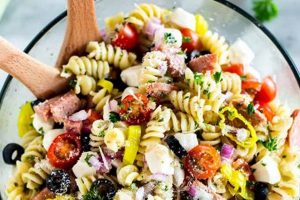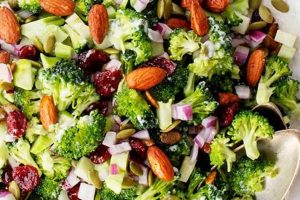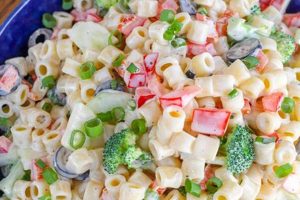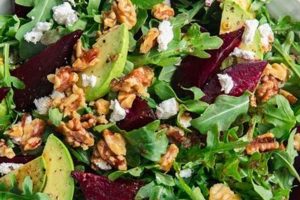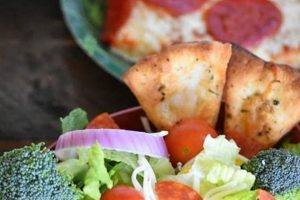Consisting primarily of flavored gelatin, often combined with fruits, vegetables, or other ingredients like nuts, marshmallows, or whipped cream, molded and chilled desserts of this type offer a diverse range of flavors and textures. A simple example might include lemon-flavored gelatin with canned fruit cocktail suspended within.
These dishes gained popularity, particularly in mid-20th century America, due to their ease of preparation, affordability, and attractive presentation. The refreshing and light nature of these molded desserts made them a popular choice for holidays, potlucks, and summertime meals. Their adaptability allows for both sweet and savory variations, showcasing the versatility of gelatin as a culinary ingredient.
This exploration will delve further into the world of these molded delights, covering variations, preparation techniques, historical influences, and modern adaptations.
Tips for Creating Successful Gelatin Salads
Achieving the desired texture and flavor requires attention to several key details. The following tips offer guidance for optimal results.
Tip 1: Bloom the Gelatin Properly: Gelatin must be softened in cold liquid before dissolving in hot. This ensures even hydration and prevents clumping. Follow package instructions for specific blooming times.
Tip 2: Dissolve Gelatin Completely: Stir the bloomed gelatin into hot liquid until fully dissolved, ensuring no granules remain. Undissolved gelatin can lead to an unpleasant texture.
Tip 3: Chill Gradually: Allow the mixture to cool slightly before adding other ingredients. This prevents delicate ingredients, like fruits, from sinking to the bottom or becoming overcooked.
Tip 4: Choose Complementary Flavors: Consider the flavor profile of the chosen gelatin and pair it with compatible ingredients. For instance, lime gelatin complements tropical fruits, while orange gelatin works well with citrus segments and berries.
Tip 5: Layer for Visual Appeal: Creating layers of different colors and textures enhances the visual appeal. Allow each layer to set partially before adding the next for distinct separation.
Tip 6: Unmold with Care: To unmold, briefly dip the mold in warm water. This loosens the gelatin from the sides, allowing it to release cleanly onto a serving plate.
Tip 7: Consider the Occasion: Adapt the recipe to suit the occasion. A simple fruit-filled mold is suitable for a casual gathering, while a more elaborate layered creation might be reserved for a special celebration.
By following these guidelines, one can create visually appealing and flavorful gelatin dishes that are sure to impress.
These tips provide a solid foundation for crafting delightful gelatin creations, leading to a rewarding culinary experience.
1. Gelatin Selection (Flavor, Type)
Gelatin selection significantly impacts the final product in gelatin salad recipes. Flavor choices should complement intended inclusions. For example, a neutral-flavored gelatin, such as unflavored or lemon, allows the flavors of added fruits or vegetables to take center stage. Conversely, a bolder flavor like cherry or orange can enhance complementary ingredients or provide a dominant flavor profile. Beyond flavor, the type of gelatin also plays a crucial role. Powdered gelatin is the most common, offering versatility and control over setting strength. Sheet gelatin, while less readily available, provides a clearer, more refined texture, often preferred for elegant presentations. The specific type chosen will influence the recipes liquid ratios and setting times.
Consider a tropical fruit salad suspended in a coconut-flavored gelatin. The coconut flavor enhances the tropical theme, creating a cohesive and harmonious taste experience. Alternatively, a savory aspic featuring vegetables encased in a clear, unflavored gelatin allows the natural flavors and colors of the vegetables to shine through. Choosing an inappropriate flavor can clash with or mask delicate ingredients, leading to an unbalanced final product. Similarly, neglecting to consider the setting strength of different gelatin types can result in either a weak, unstable structure or an overly firm, rubbery texture. Understanding the nuances of each gelatin option empowers recipe customization and ensures the desired outcome.
Appropriate gelatin selection is fundamental to a successful gelatin salad recipe. Careful consideration of both flavor and type ensures the desired balance and structural integrity of the dish, transforming a simple collection of ingredients into a harmonious and visually appealing culinary creation. Failing to prioritize gelatin selection can compromise the final product, affecting both taste and presentation. Recognizing this crucial step allows for informed ingredient choices, leading to a more satisfying and successful culinary endeavor.
2. Liquid component (water, juice)
The liquid component is fundamental to the structure and flavor profile of a gelatin salad recipe. It serves as the dissolving agent for the gelatin granules, hydrating them and facilitating the formation of the gel structure upon cooling. The choice of liquid significantly influences the final product’s taste, color, and overall appeal.
- Flavor Infusion
The liquid chosen directly impacts the flavor profile of the finished dish. Water provides a neutral base, allowing the flavors of other ingredients, such as added fruits or flavor extracts, to dominate. Conversely, fruit juices, broths, or other flavored liquids infuse the gelatin with their inherent taste, complementing or enhancing the other components. For example, cranberry juice adds a tartness that balances the sweetness of added fruits, while chicken broth creates a savory base for vegetable or meat-based aspic.
- Color Enhancement
The liquid’s color contributes to the visual appeal of the final product. Clear liquids, such as water or white grape juice, create a transparent canvas that showcases the colors of suspended ingredients. Juices and other colored liquids add their own hues, deepening or altering the overall appearance. For instance, using beet juice results in a vibrant pink hue, while tomato juice lends a reddish-orange tint.
- Gel Strength Influence
Certain liquids can influence the setting strength of gelatin. Highly acidic liquids, like citrus juices, can inhibit gel formation if used in excessive amounts. Balancing acidity with other liquids or adjusting the gelatin concentration is crucial for achieving the desired texture. For example, combining orange juice with water ensures proper setting while imparting the desired citrus flavor.
- Clarity and Texture
The clarity of the liquid impacts the final appearance of the gelatin. Filtered water or clear juices contribute to a transparent, jewel-like finish, while pulpy juices or those containing suspended solids can create a more opaque or textured result. This characteristic can be utilized strategically, choosing a clear liquid to showcase layered ingredients or a cloudy liquid for a more rustic appearance.
The careful selection of the liquid component is therefore essential for a successful gelatin salad recipe. It contributes not only to the structural integrity of the dish but also to its flavor, color, and overall sensory experience. Understanding the interplay between the liquid and other ingredients empowers informed decision-making, leading to a more refined and satisfying culinary creation.
3. Sweetener (sugar, alternatives)
Sweeteners play a crucial role in gelatin salad recipes, balancing flavors and contributing to the overall sensory experience. The choice of sweetener influences not only the perceived sweetness but also the texture and stability of the final product. Understanding the function and impact of various sweeteners allows for informed decisions regarding flavor profiles and dietary considerations.
- Granulated Sugar
Granulated sugar is the most common sweetener in traditional gelatin salad recipes. Its readily available and provides a clean, predictable sweetness. The amount of sugar used can be adjusted to achieve the desired level of sweetness, accommodating personal preferences and the sweetness of other ingredients, such as fruits or flavored gelatin mixes. Excessive sugar can hinder proper setting, while insufficient amounts may result in a bland or tart final product.
- Honey or Maple Syrup
Honey or maple syrup offer natural alternatives to granulated sugar, introducing subtle flavor nuances and potential health benefits. These liquid sweeteners can slightly alter the texture of the gelatin, potentially resulting in a softer set. Careful consideration of the liquid volume contributed by these sweeteners is necessary to maintain the desired gelatin consistency.
- Artificial Sweeteners
Artificial sweeteners provide a low-calorie or sugar-free option for those with dietary restrictions. These sweeteners vary in intensity, requiring careful adjustment to achieve the desired level of sweetness. Some artificial sweeteners may impart a slightly different aftertaste or texture compared to sugar, impacting the overall sensory experience.
- Fruit Concentrates/Purees
Fruit concentrates or purees offer natural sweetness and intensify fruit flavors in gelatin salads. These options contribute additional liquid and may impact the final setting strength of the gelatin. Balancing the sweetness and liquid contribution of fruit-based sweeteners is crucial for achieving the desired texture and flavor profile.
The selection of a sweetener significantly influences the flavor profile, texture, and dietary suitability of a gelatin salad. Careful consideration of the chosen sweetener in relation to other ingredients and desired characteristics ensures a balanced and satisfying final product. Understanding the interplay between sweeteners and gelatin allows for informed decision-making and recipe customization, leading to a successful and enjoyable culinary outcome.
4. Inclusions (fruits, vegetables)
Inclusions, primarily fruits and vegetables, define the character of a gelatin salad recipe, contributing flavor, texture, and visual appeal. These additions transform a simple gelatin base into a complex culinary creation. The selection and preparation of inclusions significantly impact the final product’s palatability and aesthetic qualities. Consider the interplay between a tart cranberry gelatin and the sweetness of embedded mandarin orange segments. The contrasting flavors and textures create a balanced and refreshing sensory experience. Alternatively, a savory aspic featuring finely diced vegetables suspended in a clear gelatin demonstrates the versatility of inclusions in both sweet and savory applications.
The structural integrity of the gelatin mold influences the choice and preparation of inclusions. Dense or heavy ingredients may sink to the bottom in a weakly set gelatin, while delicate fruits might become discolored or mushy if subjected to excessive heat during preparation. Blanching certain vegetables helps maintain their color and texture within the gelatin matrix. Consider the difference between adding fresh berries, which might bleed their color into the gelatin, and using canned or frozen varieties that retain their vibrancy. Such choices affect not only the visual appeal but also the overall balance of flavors. Understanding these factors enables informed decisions, leading to a more harmonious and appealing final product.
Inclusion selection and preparation are thus integral to a successful gelatin salad recipe. Careful consideration of ingredient compatibility, structural integrity, and desired aesthetic qualities ensures a balanced and visually appealing dish. A deep understanding of these elements elevates the gelatin salad from a simple dish to a carefully constructed culinary creation, showcasing both creativity and technical skill. Failure to consider these aspects can result in an unbalanced or unappealing dish, highlighting the crucial role inclusions play in the overall success of the recipe.
5. Mold preparation (greasing, chilling)
Mold preparation is a crucial step in gelatin salad recipes, directly impacting the ease of unmolding and the final presentation. Greasing the mold with a thin layer of cooking spray or oil creates a barrier between the gelatin and the mold surface, preventing adhesion and ensuring clean release upon inversion. Chilling the prepared mold prior to adding the gelatin mixture aids in rapid setting of the initial layer, preventing the dispersion of added ingredients, particularly in layered creations. This pre-chilling step contributes to well-defined layers and a polished final appearance.
Consider a multi-layered gelatin salad featuring distinct color bands. Without proper greasing, the layers may adhere to the mold, tearing upon removal and disrupting the intended design. Similarly, neglecting the chilling step could result in the colors bleeding together as the initial layers fail to set quickly enough, compromising the visual appeal. Adequate mold preparation, therefore, directly contributes to a visually appealing and structurally sound final product. Conversely, insufficient preparation can lead to a frustrating unmolding experience and a compromised presentation, detracting from the overall quality of the dish.
Effective mold preparation, encompassing both greasing and chilling, is an essential component of successful gelatin salad recipes. This seemingly minor step significantly influences the ease of unmolding, the preservation of layered designs, and the overall aesthetic appeal of the finished product. Overlooking this crucial stage can compromise both the structural integrity and visual presentation of the dish, underscoring the importance of meticulous mold preparation in achieving a polished and satisfying culinary result.
6. Layering techniques (colors, textures)
Layering techniques are central to elevating gelatin salad recipes from simple molded desserts to visually stunning culinary creations. Strategic layering enhances aesthetic appeal and introduces textural complexity, transforming the dish into a multi-sensory experience. Understanding the principles of layering, including color coordination and textural variation, allows for creative expression and a polished presentation.
- Color Coordination
Color coordination is fundamental to visually appealing layered gelatin salads. Contrasting or complementary color combinations create visual interest and enhance the presentation. Consider alternating layers of vibrant red strawberry gelatin with creamy white vanilla yogurt gelatin. The stark color contrast creates a visually striking dessert. Alternatively, layering varying shades of green, from a light lime gelatin to a deeper mint layer, offers a monochromatic yet visually appealing presentation. Harmonious color choices elevate the dish from a simple dessert to an aesthetically pleasing culinary creation.
- Textural Variation
Layering different textures adds a dynamic element to gelatin salads, engaging multiple senses. Incorporating layers of smooth gelatin with sections of chopped fruits, nuts, or shredded coconut creates textural contrast and enhances the eating experience. Imagine a layer of smooth lemon gelatin followed by a layer of crushed pineapple suspended in a lighter gelatin. The interplay of smooth and chunky textures provides a more engaging and satisfying culinary experience.
- Ingredient Density
The density of incorporated ingredients influences layering success. Denser ingredients, such as chopped fruits or nuts, tend to sink in a less viscous gelatin layer. Allowing each layer to partially set before adding the next prevents ingredient migration and maintains distinct separation. This technique is crucial for achieving visually defined layers and preventing a muddled appearance. Understanding ingredient density and setting times allows for precise layering and a polished final product.
- Clarity vs. Opacity
The interplay of clear and opaque layers adds visual depth and complexity to a gelatin salad. Alternating layers of clear gelatin, showcasing suspended ingredients, with opaque layers, created by incorporating ingredients like cream or yogurt, creates a visually dynamic presentation. Consider a layered dessert featuring a clear layer of gelatin with suspended fruit pieces followed by an opaque layer of vanilla yogurt gelatin. The alternating clarity and opacity enhance the visual appeal and showcase the artistry of layering.
Mastering layering techniques elevates gelatin salad recipes from simple desserts to sophisticated culinary creations. Strategic color coordination, textural variation, and an understanding of ingredient density and layer clarity contribute to visually stunning and texturally complex dishes. These techniques empower culinary creativity, transforming a basic gelatin mold into a showcase of artistry and flavor.
7. Unmolding process (warm water bath)
The unmolding process is a critical final step in gelatin salad preparation, determining the presentation and structural integrity of the finished dish. A warm water bath technique facilitates the clean release of the gelatin from its mold, preserving the intricate details and layered designs. Improper unmolding can result in a fractured or misshapen dessert, undermining prior efforts. This delicate procedure requires careful temperature control and precise timing to maintain the structural integrity of the gelatin.
- Temperature Control
Precise temperature control is essential for successful unmolding. Excessively hot water can melt the gelatin, resulting in a distorted shape and loss of structural integrity. Conversely, insufficiently warm water may fail to adequately loosen the gelatin from the mold, leading to resistance during release and potential tearing. A brief immersion in warm, not hot, water is ideal, typically ranging from 10-30 seconds depending on the mold material and gelatin thickness. This delicate balance ensures a smooth and damage-free release.
- Immersion Depth and Duration
The depth and duration of the warm water bath are crucial factors influencing unmolding success. The water level should reach just below the rim of the mold, avoiding submersion of the gelatin itself. Prolonged immersion, even in moderately warm water, can soften the gelatin’s outer layer, compromising its shape and structural integrity. A brief, controlled immersion strikes the optimal balance between loosening the gelatin from the mold and preserving its form. Observing the subtle separation of the gelatin from the mold’s edges indicates sufficient warming.
- Inversion Technique
The inversion technique employed significantly influences the clean release of the gelatin. A swift, decisive inversion onto a serving plate minimizes the risk of tearing or uneven detachment. Hesitation or partial inversion can create air pockets between the gelatin and the plate, hindering complete release and potentially damaging the delicate structure. Positioning the serving plate directly over the mold before inverting ensures a centered presentation and minimizes handling after release.
- Mold Material Considerations
Mold material influences the unmolding process. Metal molds conduct heat more readily, requiring shorter immersion times compared to glass or plastic molds. Intricate mold designs with fine details or sharp corners may require additional care during unmolding to prevent breakage or tearing. Understanding the properties of the chosen mold material and its impact on heat transfer informs adjustments to the warm water bath technique, optimizing the unmolding process for specific mold types.
Proper unmolding, utilizing the warm water bath technique, is essential for showcasing the artistry and effort invested in preparing a gelatin salad. Careful temperature control, precise immersion depth and duration, a confident inversion technique, and consideration of mold material all contribute to a flawless presentation. Mastery of this final step ensures that the gelatin salad is presented in its intended form, preserving the delicate balance of flavors, textures, and visual appeal. This careful execution transforms a simple dessert into a culinary accomplishment, demonstrating both skill and attention to detail.
Frequently Asked Questions
Addressing common inquiries regarding gelatin salad recipes clarifies techniques and encourages culinary exploration.
Question 1: How can one prevent gelatin from setting too firmly or becoming rubbery?
Adjusting the gelatin-to-liquid ratio influences the final texture. Using slightly less gelatin than the recipe specifies or increasing the liquid component yields a softer set. Additionally, highly acidic ingredients can inhibit gelatinization; therefore, balancing acidity with other liquids ensures proper setting.
Question 2: What methods prevent fruit from sinking to the bottom of the mold?
Allowing the gelatin mixture to cool slightly before adding fruit prevents immediate sinking. Distributing fruit evenly throughout a partially set base also helps maintain uniform suspension. For denser fruits, layering techniques, where each layer sets partially before adding the next, ensures proper distribution and prevents settling.
Question 3: Can alternative sweeteners be used in gelatin salads, and how do they impact the final product?
Honey, maple syrup, or artificial sweeteners can substitute for granulated sugar. However, their liquid content and varying sweetness levels require adjustments to the recipe. Honey and maple syrup can result in a softer set due to increased liquid, while artificial sweeteners necessitate careful measurement to match desired sweetness without impacting texture.
Question 4: How can one ensure a smooth, flawless surface when unmolding a gelatin salad?
Proper mold preparation is crucial. Lightly greasing the mold with cooking spray or oil prevents adhesion. Briefly dipping the mold in warm water loosens the gelatin, facilitating clean release. A swift, decisive inversion onto a serving plate minimizes disruption and preserves the molded design.
Question 5: What techniques can be employed to create visually appealing layered gelatin salads?
Allowing each layer to set partially before adding the next prevents color bleeding and maintains distinct separation. Using contrasting or complementary color combinations enhances visual appeal. Incorporating a variety of textures through layered ingredients like fruit pieces, nuts, or shredded coconut adds visual and textural interest.
Question 6: How can one adapt gelatin salad recipes to accommodate dietary restrictions or preferences?
Substituting fruit juice for water or adding fruit purees adjusts sweetness and flavor profiles without refined sugar. Agar-agar offers a vegan alternative to traditional gelatin. Adapting ingredients, such as using fresh or canned fruits based on dietary needs, caters to specific preferences without compromising the overall dish.
Understanding these common concerns empowers confident experimentation with flavors, textures, and presentations in gelatin salad recipes.
This concludes the frequently asked questions section. The following section will explore
Conclusion
This exploration has provided a comprehensive overview of gelatin salad recipes, encompassing ingredient selection, preparation techniques, and presentation strategies. From the foundational role of gelatin selection and liquid components to the artistry of layering and the delicate process of unmolding, each element contributes to the final product’s success. Understanding the interplay of flavors, textures, and visual elements empowers culinary creativity and ensures a satisfying outcome. Emphasis on careful mold preparation, ingredient compatibility, and precise temperature control during unmolding underscores the technical precision required for achieving both structural integrity and aesthetic appeal. Adaptability to dietary restrictions and personal preferences further highlights the versatility of gelatin salads within the culinary landscape.
The enduring appeal of gelatin salads lies in their adaptability and potential for creative expression. Continued exploration of flavor combinations, textural variations, and innovative presentation methods ensures the ongoing evolution of this culinary classic. From traditional holiday staples to modern reinterpretations, gelatin salads offer a platform for culinary innovation, inviting both novice and experienced cooks to explore the boundless possibilities within this seemingly simple yet remarkably versatile dish.

